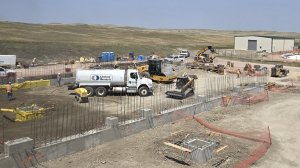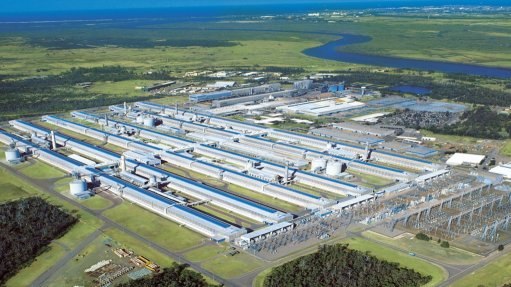Lance uranium recovery plant modification proceeding on schedule, Peninsula says
Plant construction and wellfield development activities at ASX- and OTCQB-listed Peninsula Energy and its wholly-owned US subsidiary Strata Energy’s Lance project, in Wyoming, are progressing on schedule and close to budget.
Peninsula is modifying and expanding the Ross uranium recovery process plant and auxiliary facilities at Lance, which were originally built in 2015 as an alkaline in-situ recovery (ISR) satellite plant, for an expanded production capacity using the low-pH ISR process, and to include the complete central processing plant (CPP) capability of producing a finished dry yellowcake product.
The expanded CPP (Phase II expansion) will house additional ion-exchange circuit capacity along with new resin elution, precipitation, filtration and product drying circuits.
On completion of Phase II construction, the Lance project will boast a 5 000-gallon-a-minute uranium recovery ion-exchange process plant with the capability to independently produce up to two-million pounds a year of dry yellowcake, or triuranium octoxide, product.
In June, the company was awarded the Wyoming Governor’s Safety Award during the Wyoming Mining Association Annual Convention. This is the third year running that the company has been honored with this award that recognises the company’s commitment to safety and its outstanding record of seven consecutive years with no employee lost-time accidents.
“Rapid progress was evident across the Lance project in July as teams of workers were busy preparing the project to resume uranium production operations by the end of this year.
“The entire site is buzzing with the [activity] of a construction project in full swing. Our preparations are continuing to proceed safely, smoothly and on schedule,” Peninsula MD and CEO Wayne Heili said on July 31.
PLANT CONSTRUCTION
Peninsula said all major piping and tank modifications for low-pH ISR operations have been completed inside the previously built Ross satellite plant.
To date, the Phase II expansion project efforts have remained focused on major equipment procurement and preparation of the building foundations.
About 87% of building foundations have been installed, with about 191 m3 of concrete placed. The remaining foundations have been intentionally left open for better access to set structural steel and process equipment within the plant building footprint.
Concrete work will continue into August, after which the plant construction schedule will be shifted to an around-the-clock rotation, allowing the different trades to work with less interference.
The structural steel and additional materials for the processing plant building have been delivered to site. The building will be erected once the concrete foundations and slab have met design strength and the major equipment is placed.
Sections of the steel building structure are being prefabricated at the site so they can be moved into place when needed.
Equipment procurement activities remained on schedule with all of the major equipment on order. Expected delivery dates were meeting or exceeding the requirements of the construction schedule, Peninsula said.
The first piece of major equipment for the project was received six weeks ahead of expected delivery, and process tanks for the southern half of the building have all been received at site.
To date, overall equipment costs were tracking the budget, the company noted.
In addition to the Phase II expansion construction work, the company is also preparing auxiliary facilities designed to improve low-pH ISR operations.
The company said that, in recent months, a free-standing building was constructed to house fine solids separation and removal equipment. The process equipment had been installed in the building and the site construction team had started to install the piping and electrical connections.
Peninsula said the removal of suspended solids from the ISR production stream would enhance operational efficiency.
WELLFIELD DEVELOPMENT
In addition to plant construction activities, Peninsula’s employee and drilling contractor teams continue to advance the development of new wellfield facilities.
The previously developed wellfield areas of mine units 1 (MU-1) and 2 (MU-2) are available for resumption of uranium recovery operations. However, the company is actively developing a new wellfield production area MU-3.
The company completed installation of the required monitoring well network for MU-3 in 2023. A complete data package documenting the baseline water quality and hydrologic properties of the unit was submitted to the Wyoming regulatory authorities as is required for all new ISR production areas.
Regulatory review and approval are expected to follow a 90-day timeline.
The company currently has 11 drilling rigs under contract to install ISR pattern injection and production wells in the new MU-3 area. Header house 11 (HH-11) will be the first of three modules placed into production in MU-3.
So far, the installation of the pattern wells for HH-11 is 97% complete, with the surface facilities for HH-11, which include the header house building, well plumbing, electrical connections and meter runs, 63% complete.
In addition, the construction of wellfield infrastructure, such as pipelines, powerlines, fences and roads for MU-3, was 71% complete, Peninsula reported.
The company said the preparation of HH-11 was on schedule to allow the start of preconditioning operations in the third quarter.
OPERATIONS
Peninsula said the production restart scheduled for later this year would be marked by the progressive commissioning of the new CPP circuits following the initial recovery of uranium delivered to the plant ion-exchange circuit from wellfield solutions.
The company recommenced wellfield preconditioning operations in MU-1 at Lance during July. It explained that, to successfully employ the low-pH ISR methodology, it was necessary to reduce the wellfield solution pH from the natural baseline level down to a pH of about two standard units.
To accomplish this, the host formation is flushed with preconditioned low pH solutions.
Each new operational area is expected to be preconditioned over two to three months, before being introduced to the process plant uranium recovery circuit.
Peninsula said that MU-1 was now being preconditioned so that the wellfield would be ready for production operations the process plant became available. The first header house in the new MU-3 would also be preconditioned in sequence prior to commencing uranium recovery operations in the plant.
In addition to preconditioning operations, the company said that the Lance team had been conducting laboratory and pilot-scale testing on solutions produced from the wellfield to ensure operational familiarity with the new additional process steps and to ensure the project would function at a high level from the start of production.
Peninsula said the advanced testing of the process operations had led to a greater confidence that the project could produce a high-quality finished product while minimising process losses.
PRODUCTION GUIDANCE
Following completion of updated wellfield designs for MU-3, incorporating data from ongoing wellfield development drilling, the company is expecting a slightly lower initial production ramp-up than the August 2023 life-of-mine (LoM) plan projection of 1.1-million pounds next year.
The LoM plan was prepared in advance of full project development funding being secured.
As such, the company said that it had adopted a slightly more conservative approach to its 2025 production forecast and now expected a range of between about 700 000 lb and 900 000 lb.
Peninsula said the company’s current cash balance was expected to continue to support operating and capital expenditures until the generation of self-sustaining cash flows, which remained projected for the third quarter of next year.
Article Enquiry
Email Article
Save Article
Feedback
To advertise email advertising@creamermedia.co.za or click here
Announcements
What's On
Subscribe to improve your user experience...
Option 1 (equivalent of R125 a month):
Receive a weekly copy of Creamer Media's Engineering News & Mining Weekly magazine
(print copy for those in South Africa and e-magazine for those outside of South Africa)
Receive daily email newsletters
Access to full search results
Access archive of magazine back copies
Access to Projects in Progress
Access to ONE Research Report of your choice in PDF format
Option 2 (equivalent of R375 a month):
All benefits from Option 1
PLUS
Access to Creamer Media's Research Channel Africa for ALL Research Reports, in PDF format, on various industrial and mining sectors
including Electricity; Water; Energy Transition; Hydrogen; Roads, Rail and Ports; Coal; Gold; Platinum; Battery Metals; etc.
Already a subscriber?
Forgotten your password?
Receive weekly copy of Creamer Media's Engineering News & Mining Weekly magazine (print copy for those in South Africa and e-magazine for those outside of South Africa)
➕
Recieve daily email newsletters
➕
Access to full search results
➕
Access archive of magazine back copies
➕
Access to Projects in Progress
➕
Access to ONE Research Report of your choice in PDF format
RESEARCH CHANNEL AFRICA
R4500 (equivalent of R375 a month)
SUBSCRIBEAll benefits from Option 1
➕
Access to Creamer Media's Research Channel Africa for ALL Research Reports on various industrial and mining sectors, in PDF format, including on:
Electricity
➕
Water
➕
Energy Transition
➕
Hydrogen
➕
Roads, Rail and Ports
➕
Coal
➕
Gold
➕
Platinum
➕
Battery Metals
➕
etc.
Receive all benefits from Option 1 or Option 2 delivered to numerous people at your company
➕
Multiple User names and Passwords for simultaneous log-ins
➕
Intranet integration access to all in your organisation




















